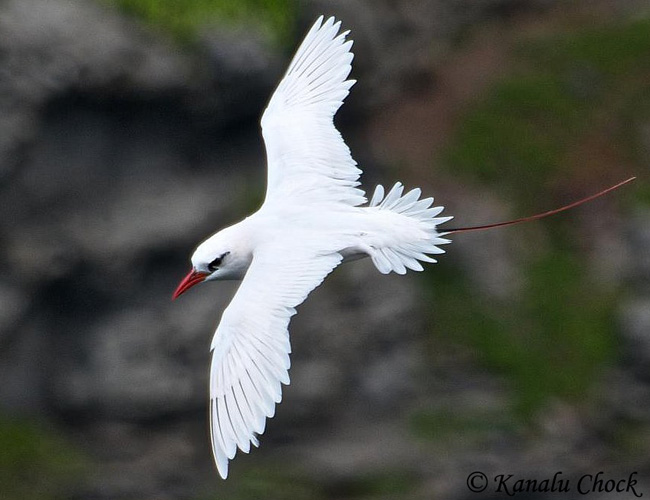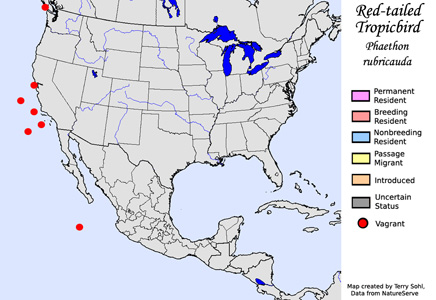| Length: 16 inches, up to 32 inches with tail | Wingspan: 38 inches | Seasonality: Non-resident in South Dakota |
| ID Keys: Plumage almost completely white with a variable pinkish overtone, dark eye line, reddish bill, long red tail plume on adults | ||
 The
Red-tailed Tropicbird is a bird of the tropical Pacific and Indian Oceans.
In North America, they are only known by the rare vagrant that has
occasionally been sighted off the west coast of the United States, with one
sighting as far north as near Vancouver, Canada. Approximately half of
the world's population are thought to nest in the Hawaiian Islands chain,
with the largest concentrations of breeding birds found at Midway Atoll.
The
Red-tailed Tropicbird is a bird of the tropical Pacific and Indian Oceans.
In North America, they are only known by the rare vagrant that has
occasionally been sighted off the west coast of the United States, with one
sighting as far north as near Vancouver, Canada. Approximately half of
the world's population are thought to nest in the Hawaiian Islands chain,
with the largest concentrations of breeding birds found at Midway Atoll.
Habitat: Found on and around tropical islands of the Pacific and Indian Oceans. When feeding, they are typically far from land, and nearly always found in areas with water temperatures between 24 and 30 degrees Celsius.
Diet: Feeds heavily on fish, especially flying fish, as well as squid and crustaceans.
Behavior: Feeds by flying over the water's surface and plunge-diving when prey is spotted. They also will sometimes skim the water's surface and capture prey in flight, especially when hunting for flying fish.
Nesting: Breeds in isolated pairs or in small nesting colonies, using either inaccessible cliffs and other rocky areas for nesting, or sometimes nesting directly on the ground near the protection of a shrub or small tree. A single egg is laid, placed either directly on the ground, or in a shallow scrape that is sometimes lined with bits of vegetation. Both parents will help to incubate the egg, and both parents tend to the chick after hatching.
Song: Usually quiet away from the breeding grounds. On breeding grounds, has a variety of throaty squawking and squealing sounds.
Migration: Breeding occurs on select islands in the tropical Indian and Pacific Oceans. They often stay relatively close to breeding locations, but some birds wander widely throughout the tropical Indian and Pacific Oceans, with individual birds occasionally found thousands of miles from known breeding sites. They do have a preference for warmer ocean waters, and any long-distance movements by individual birds often follow warm ocean currents.
Interactive eBird Map: Click here to access an interactive eBird map of Red-tailed Tropicbird sightings
Similar Species: White-tailed Tropicbird, Red-billed Tropicbird
Conservation Status: Global populations are likely below 50,000 individuals, but populations appear to be relatively stable. The IUCN lists the Red-tailed Tropicbird as a species of "Least Concern".
Further Information: 1) WhatBird - Red-tailed Tropicbird
2) BirdLife International - Red-tailed Tropicbird
3) Fish and Wildlife Fund - Red-tailed Tropicbird
Photo Information: Photo taken by Kanalu Chock - Photo licensed under Creative Commons Attribution ShareAlike 2.0 Generic License
| Click below for a higher-resolution map |
 |
| South Dakota Status: Non-resident in South Dakota |
Additional Red-tailed Tropicbird (coming soon!!)
